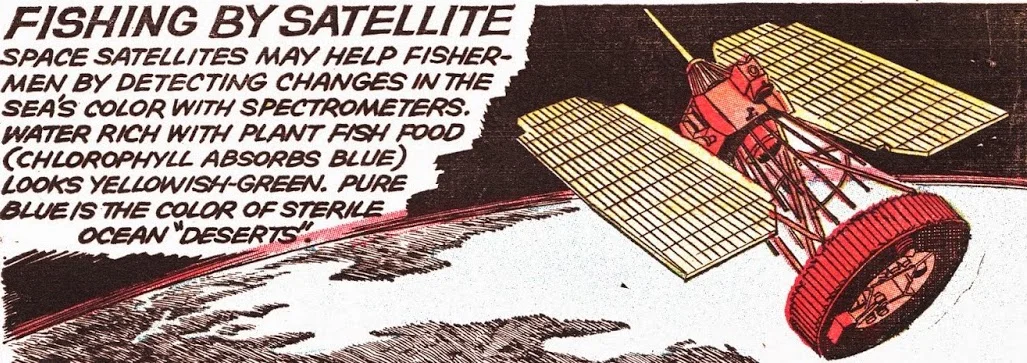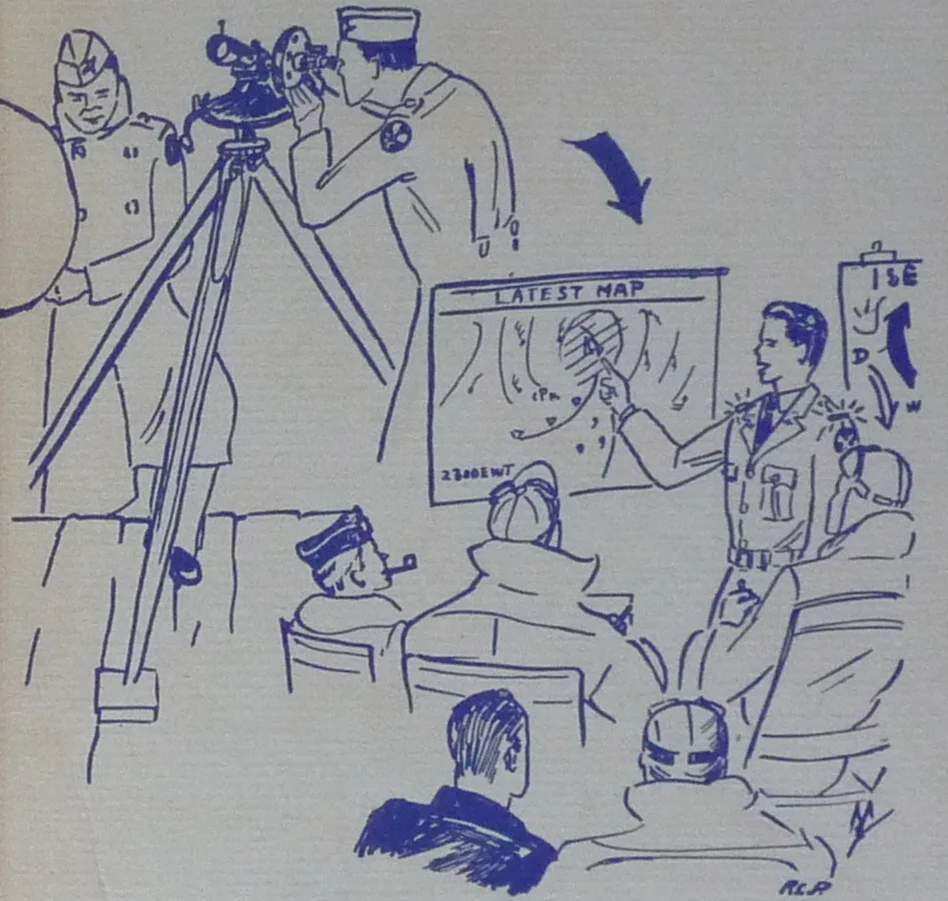20th Weather Squadron in Korea, 1950
Image from a sketchbook commemorating service during the Korean War. Abril, illustrator (no first name listed). The 20th Weather Sqdn in Korea (1951). NOAA Central Library, Rare Books Collection. Images digitized as part of the NOAA Photo Library, and used under a Creative Commons License. Original Caption: "The 20th Weather Squadron came into Korea with the first Air Force contingent and served from Taejon back to the Pusan Perimeter and forward again to within sight of the Yalu River. It furnished weather service to all United Nations forces and operated from one end of Korea to the other, from air bases in the rear to enemy-facing forward positions."
This week's images emerged from the chaotic early months of the Korean War, when invading North Korean forces surged down the peninsula and nearly drove South Korea and American troops into the sea, only to be cut off by an amphibious invasion and routed nearly back to the Chinese border. China then intervened with an influx of troops that pushed the United Nations Command steadily southward until the battle lines stabilized near the 38th parallel, the line that marked the division at the beginning of the war.
Weather was central to military operations during the war. While the UN forces were generally able to maintain air superiority, the North Koreans and Chinese often timed their ground attacks to coincide with periods of poor flying weather. Reliable observations and predictions of Korean weather were thus much desired by the United States and its allies, but quite difficult to achieve in practice.
These sketches illustrate the work of the US Air Weather Service’s 20th squadron, based in Japan. Elements of the squadron were airlifted into South Korea within 48 hours after the North’s invasion on June 25th, 1950. The squadron managed military meteorology for the United Nations Command in Korea until relieved by the 30th squadron, newly established in Seoul in November, 1950.
Personnel made weather observations from mobile posts close the front lines, sometimes within sight of active combat and fighter-bomber targets. The unit set up air-transportable mobile weather stations at temporary forward air bases, burrowing into sandbagged bunkers and Jamesway shelters.
Meteorological observers launched radiosondes to gather upper air data while exposed to sniper fire from dispersed North Korean units. Staff Sgt. Charles J. Staub, who had been the first US weatherman to reach France on D-Day during World War II, won a Commendation Ribbon for “voluntarily travel[ing] through guerilla infested areas to inspect and repair weather station equipment.”[1]
Original Caption: "Somewhere in Korea Staff Weather Officers of the 20th brief the Commanding General and Staff of the 8th Army, Commanding General and Staff of the 5th Air Force, Republic of Korea President Syngman Rhee and advisors, and U.S. Ambassador Muccio on weather for tomorrow's operations."
Squadron officers briefed planners and commanders at many levels, from squadron commanders to senior generals all the way up to South Korean President Syngman Rhee.
Despite the 20th squadron’s hard work and bravery, the Air Weather Service’s forecasting work failed to meet the demands placed upon it. By 1953 for instance, Bomber Command had abandoned efforts to use synoptic forecasts in advance planning for strategic bombing operations. Even tactical air commanders “harbored the belief that AWS meteorologists could not forecast well enough for their purposes,” according to historian John F. Fuller.
One problem lay in the personnel rotation policies. For the first five months or so of the war, weather personnel were rotated into Korea for just sixty days at a time. Tours of duty were later lengthened to six months and then one year, though still no forecaster experienced a season more than once. Experience of local weather was (again) revealed to be important for effective prediction.
But “data deficiency” posed a more fundamental problem, “the chronic disease of the Air Weather Service’s forecasts in Korea,” according to one unit history.[2] China and the Soviet Union lay upwind of Korea, and they weren’t sharing weather observations with their enemies. The ability to track air masses over long stretches of friendly territory had been crucial to the Allies in the European Theater of Operations during World War II; that geographical advantage lay with the other side in the Korean conflict.
This raises what I consider one of the great unasked questions in the history of meteorology: how did military needs for reliable weather data from enemy controlled areas drive developments in civilian weather satellites and numerical modeling?
Learn More
- John F. Fuller, Thor’s Legions: Weather Support to the U.S. Air Force and Army, 1937-1987 (American Meteorological Society, 1990): 255-270.
Image Source
All images here come from a one-of-a-kind source preserved in the NOAA Central Library’s rare books collection, a sketchbook titled The 20th Weather Sqdn in Korea. The book has 18 leaves of plates, each an illustration signed “Abril” (no first name given) and dated “ ’51 “. The illustrations were accompanied by a descriptive caption.
My assumption is that the images were drawn from memory after the illustrator rotated back to Japan with the rest of the squadron.
According to a note clipped to the back cover, this copy of the sketchbook was sent to Weather Bureau Chief Francis Reichelderfer by Lt. Col. Oliver K. Jones, Commanding Officer, 20th Weather Squadron. Reichelderfer appears to have transferred it to the Weather Bureau Library in 1957.
- Abril, The 20th Weather Sqdn in Korea (1951). NOAA Central Library, Rare Books Collection. Images digitized as part of the NOAA Photo Library, and used under a Creative Commons License.
Notes
[1] M. Sgt. Jordan, History, 20th Weather Squadron, July-December 1950, p. 201. Quoted in Fuller, Thor’s Legions, p. 270.
[2] “History of the 30th Weather Squadron,” Nov. 16-Dec. 31, 1950, p. 21. Quoted in Fuller, Thor’s Legions, p. 257.









